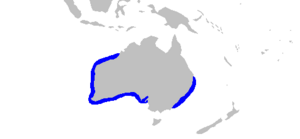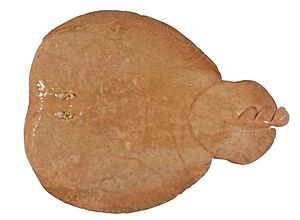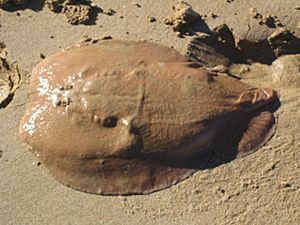Coffin ray facts for kids
Quick facts for kids Coffin ray |
|
|---|---|
 |
|
| Conservation status | |
| Scientific classification | |
| Kingdom: | |
| Phylum: | |
| Class: | |
| Subclass: | |
| Order: | |
| Family: |
Hypnidae
T. N. Gill, 1862
|
| Genus: |
Hypnos
A. H. A. Duméril, 1852
|
| Species: |
H. monopterygius
|
| Binomial name | |
| Hypnos monopterygius (G. Shaw, 1795)
|
|
 |
|
| Range of the coffin ray | |
| Synonyms | |
|
Hypnos subnigrum Duméril, 1852 |
|
The coffin ray, also called the Australian numbfish, is a special type of electric ray. It lives only in Australia's coastal waters. You can find it in shallow areas, usually less than 80 meters (260 feet) deep. This unique ray is the only member of its family, called Hypnidae.
Coffin rays are small, typically growing to about 40 cm (16 inches) long. They have a very distinct pear-like shape. This is because their pectoral fins are very wide, and their tail is extremely short. Their tiny dorsal and caudal fins are all grouped near the back. Coffin rays are usually brown on top. They have tiny eyes and a large mouth that can stretch open very wide.
This ray is quite slow and mostly active at night. It likes to hide by burying itself in sand or mud during the day. The coffin ray can create a strong electric shock of up to 200 volts. It uses this shock to catch food and protect itself. It's a fierce hunter, mainly eating bony fishes that live on the seafloor. Sometimes, it even eats fish that are bigger than itself! Coffin rays can also eat small invertebrates. Amazingly, they have even been found with small penguins and rats in their stomachs.
Female coffin rays give birth to live young, usually 4 to 8 pups in the summer. The babies grow inside the mother, getting food from a yolk sac and a special "uterine milk." If a human touches a coffin ray, they can get a strong shock. But don't worry, it's not deadly. People don't usually fish for coffin rays for food. They are tough fish and can often survive if they are accidentally caught and then released. The International Union for Conservation of Nature (IUCN) says the coffin ray is of "Least Concern" for extinction. This means its population seems healthy and not threatened.
Contents
What's in a Name? Coffin Ray's Story
The coffin ray got its first scientific name from an English zoologist named George Shaw in 1795. He thought it was a type of goosefish. Later, a French zoologist, Auguste Duméril, described the same ray in 1852. He named it Hypnos subnigrum. The name Hypnos comes from the Greek word for "sleep." This refers to the ray's ability to make things numb with its electric shock.
Eventually, scientists realized both descriptions were for the same fish. So, the proper scientific name became Hypnos monopterygius. The common name "coffin ray" comes from how the ray looks when it washes up on the beach. After death, its body can swell up, looking a bit like a coffin. Other names for this ray include crampfish, electric ray, or numbfish.
Where Do Coffin Rays Live?
The coffin ray lives in different parts of Australia's tropical and warm-temperate waters. You can find them from South Australia up to Western Australia on the west coast. On the east coast, they live from New South Wales up to Queensland. They are not found off Victoria or Tasmania.
These rays are common and live on the bottom of the ocean. They usually stay close to shore, in waters no deeper than 80 meters (260 feet). However, they have been seen as deep as 240 meters (790 feet). Coffin rays prefer sandy or muddy areas. This includes beaches, estuaries (where rivers meet the sea), and bays. They can also be found in seagrass beds and near rocky or coral reefs.
How to Spot a Coffin Ray
The coffin ray's unique pear-like shape makes it easy to tell apart from other rays. Its body is soft and flexible. It has two large, kidney-shaped electric organs on each side of its head. These organs are what produce the electric shock.
The ray's pectoral fins are very big and form a wide, round disc. This disc is thick in the middle and thin at the edges. The front edge of the disc is mostly straight. The eyes are tiny and can stick out a little on short stalks. Just behind the eyes are the spiracles, which are slightly larger. The spiracles sometimes have small bumps around them.
The nostrils are right in front of the mouth. They connect to the mouth with two wide grooves. A small flap of skin between the nostrils covers the mouth. The mouth is very wide and can open incredibly far. Adult coffin rays have over 60 rows of small teeth in each jaw. Each tooth has three long points. They have five pairs of small gill slits under their body disc.
The pelvic fins are quite large. They join with the pectoral fin disc at the front, making a second, almost circular disc. The two dorsal fins are rounded and very close to the caudal fin (tail fin). The tail fin is about the same size and has a rounded edge. The tail itself is extremely short, barely extending past the pelvic fins. The skin of the coffin ray is smooth and has no scales. Its color can be dark brown, reddish brown, grayish, pinkish, or yellowish. It might be plain or have some darker and lighter spots. The underside of the ray is pale. Coffin rays can grow up to 70 cm (28 inches) long, or even 92 cm (36 inches). But most are around 40 cm (16 inches) long.
Coffin Ray's Life and Habits
The coffin ray is a slow and weak swimmer. It moves with a jerky, fluttering motion. It is active at night and spends most of the day buried in the sand or mud. Only its spiracles show above the surface. If something disturbs it, the ray might burst out of the bottom and swim in a loop with its mouth open. This could be a way to scare off danger.
Sometimes, coffin rays get stuck on land when the tide goes out. But they can survive out of water for several hours! Like other electric rays, the coffin ray's electric organs are made from muscle tissue. These organs are like many small batteries stacked together. The ray can create up to 200 volts of electricity. It can deliver about 50 shocks in ten minutes, with each shock getting a bit weaker. The coffin ray uses electricity to stun its prey and to protect itself from predators.
The coffin ray's diet mainly consists of bony fishes that live on the seafloor. But they also eat cephalopods (like squid) and sometimes crustaceans (like crabs) and polychaete worms. As mentioned before, they have even been found with penguins and rats in their stomachs! The coffin ray hunts by hiding in the sand and then ambushing its prey. It swallows its food whole, head-first, before burying itself again. They often eat very large prey compared to their own size. One ray, 60 cm (24 inches) long, was found to have swallowed a flathead fish that was 70 cm (28 inches) long! The tail of the flathead was still sticking out of the ray's mouth. Some dead coffin rays have been found that seem to have choked trying to swallow prey that was too big.
Female coffin rays give birth to live young. The developing babies are fed by a yolk sac and a special "uterine milk" from the mother. Females usually have 4 to 8 pups in the summer. Newborns are about 8–11 cm (3–4 inches) long. Both male and female coffin rays become able to reproduce when they are about 40–48 cm (16–19 inches) long.
Coffin Rays and Humans
When you approach a coffin ray, it usually stays still and hidden on the sea floor. Because of this, many divers, swimmers, and people wading in the water have accidentally touched them and received a shock. The shock can be quite strong, but it is not dangerous or life-threatening. You can even feel the shock if you pour a stream of seawater onto the ray!
The coffin ray has no real value for fishing. In 1883, a scientist noted that it was the only ray in Port Jackson that people didn't eat. Commercial fishing boats sometimes catch coffin rays by accident. But these rays are tough and usually survive being caught and thrown back into the water. They are also sometimes caught in lobster traps. Occasionally, spear fishers might catch them. Since the coffin ray is still common and found in many places, the International Union for Conservation of Nature (IUCN) has listed it as "Least Concern". This means it's not currently at risk of extinction. Coffin rays have been kept in public aquariums, but they need to be given moving food to eat.




